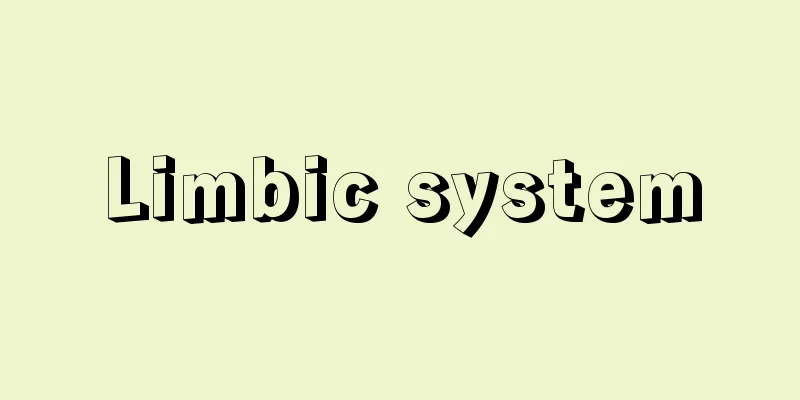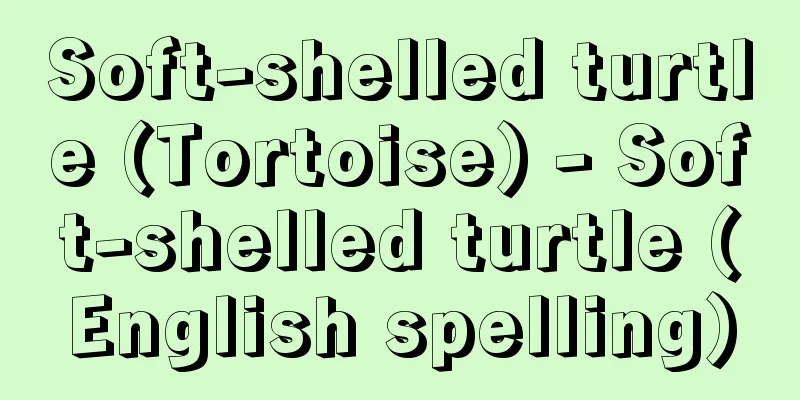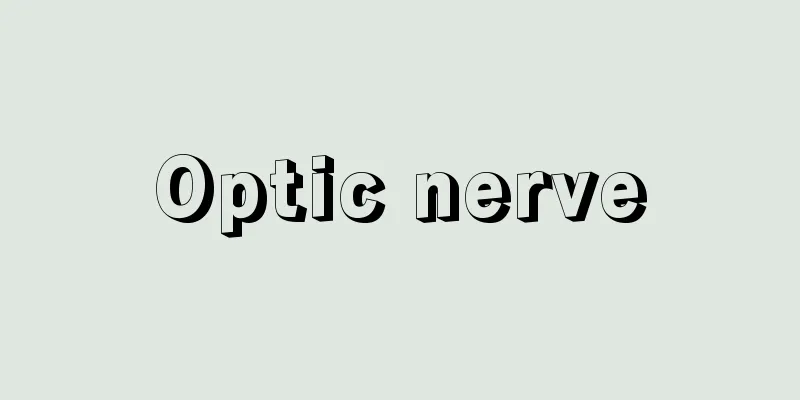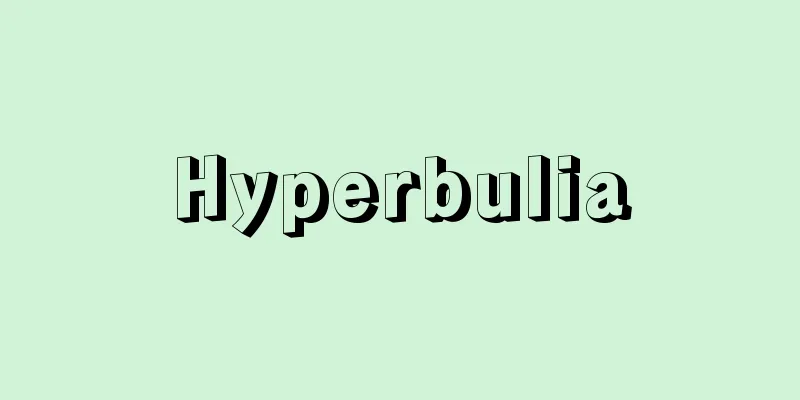Fat - shibou (English spelling) fat

|
A general term for ester compounds (glycerides) of fatty acids and glycerin. There are a wide variety of compounds depending on the type of fatty acid and the number and position of ester bonds with glycerin, but most naturally occurring compounds are triglycerides with three ester bonds. Fats are generally poorly soluble in water, but dissolve in organic solvents such as ether, chloroform, and benzene. They are widely distributed in the biological world and are important as nutrients and components of cells. Pure fats are colorless, tasteless, and odorless, but natural fats are colored by dissolving colored substances (such as carotenoids). Fats that contain a lot of unsaturated fatty acids, such as vegetable oils, have a low melting point and are easily oxidized by oxygen in the air, becoming colored and changing to an unpleasant smell or taste. When hydrolyzed with superheated steam, fatty acids and glycerin are obtained, and when boiled with caustic soda, sodium salts of fatty acids (soap) and glycerin are obtained. Fats are important for the nutrition of mammals. Fats synthesized in the body using dietary fats and excess carbohydrates as raw materials are stored in the liver and adipose tissue. For an organism to obtain energy from fats, they are first hydrolyzed by lipase into glycerin and fatty acids, and then the fatty acids are broken down into acetyl coenzyme A (one of the substrates in the citric acid cycle). In the end, fat produces about 9 kilocalories of energy per gram, which is about twice as much as carbohydrates or proteins. [Takayoshi Wakagi] Food & NutritionIn the nutrition field, fats and oils and similar substances, i.e. lipids, are sometimes called fats. This article explains when fats and lipids are used interchangeably. [Kazuo Fukuzumi and Shunichi Fukuzumi] Nutritional classification and basic properties of fatsFats can be divided into vegetable fats and animal fats. The fatty acids contained in them are mainly saturated fatty acids such as palmitic acid and stearic acid. They also contain some unsaturated fatty acids. Palmitic acid is abundant in vegetable fats, while stearic acid is abundant in animal fats. There are neutral fats and cholesterol. In meat, the white parts are neutral fats and the red parts are cholesterol. Cholesterol exists in meat in an invisible state. Neutral fats and cholesterol have different roles in the body. Neutral fats are a substance in which three fatty acids are bound to glycerol, and are an important source of energy for the body, and are stored as stored energy. On the other hand, cholesterol, along with phospholipids, is a component of cell membranes and is not used as energy. Lipids are classified as simple lipids, complex lipids, and derived lipids. Simple lipids are mainly oils and fats (neutral fats). Neutral fats are the most abundant of all lipids, and simple lipids are often referred to as fats. Complex lipids include phospholipids and glycolipids, and derived lipids include cholesterol. All of these are components of cell membranes. Phospholipids are the most abundant lipids in biological membranes (approximately 70%) and include glycerophospholipids, in which long-chain fatty acids are ester-bonded to two hydroxyl groups of glycerol and phosphoric acid is ester-bonded to the remaining hydroxyl group, and sphingophospholipids, which have a phosphate group and a long-chain base such as sphingosine (a C18 long-chain base with one double bond) instead of glycerol. They are divided into many types depending on the substances that bind to the phosphate group. Glycolipids contain both sugars and lipids in the molecule and do not have a phosphate group, but like phospholipids, they are divided into glyceroglycolipids and sphingoglycolipids. The content of glycolipids in biological membranes is relatively small (about 4-9%), but the sugar chain portion is exposed on the cell surface and is involved in the cell recognition mechanism. [Kazuo Fukuzumi and Shunichi Fukuzumi] What is Cholesterol?Cholesterol has a hydroxyl group at the polar site of the head group, and has a structure in which a hydrophobic hydrocarbon chain is bonded to a non-polar, plate-like steroid ring. It is found in relatively large amounts in biological membranes (about 20-25%), and is arranged so that the hydroxyl groups of cholesterol at the polar sites of the head groups of phospholipids and glycolipids are in contact with each other. It functions to regulate the fluidity of the lipid bilayer of the membrane and to increase the strength of the membrane. Cholesterol cannot dissolve in the blood as it is. Therefore, it is wrapped in lipoproteins and transported throughout the body. These lipoproteins include HDL (high density lipoprotein) and LDL (low density lipoprotein), which are called good cholesterol and bad cholesterol, respectively. LDL (bad) cholesterol supplies cholesterol to various parts of the body, while HDL (good) cholesterol collects excess cholesterol and prevents arteriosclerosis. When the balance between LDL and HDL is disturbed and there is an excess of LDL, it sticks to the walls of blood vessels and causes arteriosclerosis. Twenty percent of the cholesterol in the body comes from food, and 80% is synthesized within the body. As dietary habits change, people tend to consume more foods that contain a lot of cholesterol, and there is a tendency to consume less dietary fiber, which has the function of excreting bile acids, which leads to an oversupply of cholesterol. It is said that ingesting fats that are particularly high in saturated fatty acids increases the cholesterol content in the blood plasma, making one more susceptible to atherosclerosis. However, with fresh fats, as long as the intake of cholesterol is not excessive, there is little problem, but if the fat contains peroxidized fats, the risk is high. [Kazuo Fukuzumi and Shunichi Fukuzumi] Function and changes of neutral fatsIt was believed that neutral fats are digested in the small intestine by the action of bile with the help of pancreatic enzymes, hydrolyzed into fatty acids and glycerin, and then recombined inside the intestinal wall. However, it is now believed that most neutral fats pass through the small intestinal wall in a highly emulsified state without being hydrolyzed. 60% of digested fat enters the bloodstream through the thoracic duct, and the remaining digested fat is transported directly to the liver through the portal vein. It is believed that digested fat is regenerated in the liver. From the liver, fat is transported to various parts of the body through blood vessels. There is a continuous exchange of fatty substances between the liver and adipose tissue. Adipose tissue is constantly supplied with newly synthesized or resynthesized fat from the liver. If the amount of neutral fat synthesized in the liver continues to increase, the liver itself will become fatty. [Kazuo Fukuzumi and Shunichi Fukuzumi] The role of fatFats are used as an energy source. Linoleic acid and other fatty acids are called essential fatty acids and are necessary components of the body, but they cannot be synthesized in the body, so they must be ingested. However, when excess fat is ingested, it mainly increases the number of cells and stores body fat. Subcutaneous fat is difficult to accumulate, but once accumulated, it is difficult to break down. When there is an excess of energy due to overeating or lack of exercise, the fat cells in the mesentery of the small intestine actively take in neutral fats, visceral fat increases, and the body fat percentage increases even if the person does not appear fat. [Kazuo Fukuzumi and Shunichi Fukuzumi] Katsuji Nagai, Food and Health: The Function of Lipids (1989, Kenpakusha) ▽ Haruo Nakamura, ed., The Science of Lipids (1990, Asakura Publishing) ▽ Kiyotaka Sato and Masamichi Kobayashi, Structure and Dynamics of Lipids (1992, Kyoritsu Shuppan) ▽ New Biochemistry Experiment Course 4: Lipids 1: Neutral Lipids and Lipoproteins (1993, Tokyo Kagaku Dojin) edited by the Japanese Biochemical Society ▽ Kazuo Ogawa et al., Lipids and Steroids: Tissue and Cell Chemistry Techniques (1993, Asakura Publishing) ▽ Tomihiro Kurosaki and Kazuhisa Yagi, Introduction to Oil and Fat Chemistry: From Basics to Applications (1995, Sangyo Tosho) ▽ Kagemoto Yuasa, Body Fat: The Mechanism of Fat Accumulation and Decomposition (1995, Sankaido) ▽ "Hara Kenji, EPA/DHA Biochemistry and Applications - Bioactive Lipids" (1996, Saiwai Shobo)" ▽ "Kaneya Kunimitsu, Fatty Acids and Health, Lifestyle, and the Environment - From DHA to Royal Jelly" (1997, Shokabo)" ▽ "Komiya Shuichi, The Mystery of Fat Accumulating in the Body" (1998, Fumaido Publishing)" ▽ "Modern Perspectives on Fatty Acid Nutrition, Edited by the Japanese Society of Nutrition and Food Science, Igarashi Osamu and Sugawara Michihiro (1998, Koseikan)" ▽ "Toi Kazuhiko, Lesson Plan for 'Learning about the Culture of Food'" (1999, Meiji Tosho Publishing)" ▽ "Yamakawa Koji et al., Organic Chemistry, 3rd Revised Edition (1999, Nanzando)" ▽ "Diet to reduce neutral fats: A lifestyle technique to prevent arteriosclerosis by reducing neutral fats with a little ingenuity in eating habits" edited by Kazuo Kondo and Kumi Imaizumi (2000, Seibidoshuppan)" ▽ "New Easy Nutrition - Based on the Sixth Revised Japanese Nutritional Requirements" by Goro Koike (2000, Japan Women's University Press)" ▽ "Latest Information on Lipid Research - Considering Appropriate Intake" by Hiroshige Itakura et al. (2000, Daiichi Shuppan)" ▽ "'Oil' Speaks Out - Theory of Oil and Fat Nutrition" by Michihiro Kanno (2000, Kodansha)" ▽ "New Developments in Functional Lipids" edited by Osamu Suzuki et al. (2001, CMC)" ▽ "Biology of Sugar and Lipids" edited by Toshisuke Kawazaki, Keizo Inoue and the Japanese Biochemical Society (2001, Kyoritsu Shuppan)" ▽ "Basic Knowledge of Cholesterol and Neutral Fat" edited by Yoshitoyo Fujiyama (2001, Nitto Shoin) ▽ "The 5th edition of the Japanese Food Composition Tables," edited by the Food Ingredients Research Survey Committee (2001, Ishiyaku Publishing)" ▽ "Lipid Nutrition Series 1: Brain Function and Lipids," edited by Okuyama Harumi and Ando Susumu" ▽ "Lipid Nutrition Series 3: Fats and Allergies," edited by Okuyama Harumi, Kobayashi Tetsuyuki et al." ▽ "Lipid Nutrition Series 4: Lipids and Cancer," written by Takada Hideho and Hamasaki Tomohito" ▽ "Lipid Nutrition Series 5: Heart and Cerebrovascular Atherosclerosis and Lipid Nutrition," written by Yanagisawa Atsuo, Hamasaki Tomohito et al. (2001-2003, Kansai Academic Society Center)" ▽ "Natural Products Chemistry," 6th revised edition, edited by Tanaka Osamu et al. (2002, Nanzando)" ▽ "The Science of Healthy Behavior: Body Composition -- Nutrition, Exercise, and Health," written by Komiya Shuichi and Nakao Buhei (2002, Gihodo Publishing)" ▽ "Booklet (Illustrated), edited by Okuyama Harumi et al., supervised by the Japanese Society for Lipid Nutrition Preventing Heart Disease: From the Cholesterol Hypothesis to the n-6/n-3 Balance of Fatty Acids (2002, Kansai Academic Society Center) ▽ Miyagawa Takaaki, Lipids and the Story (2002, Saiwai Shobo) ▽ National Institute of Health and Nutrition Supervised, Tanaka Heizo and Sakamoto Motoko, Dietary Guidelines (2002, Daiichi Publishing) ▽ Tagawa Kunio, Metabolic Nutrition from the Viewpoint of the Body's Functions (2003, Takara Bio, Maruzen Publishing) ▽ Marumoto Yoshio and Marumoto Yasuo, Illustrated Nutrition for Abundance 2: The Key to Health - Eat Fats Properly (Shinchosha Bunko) [References] | | | | | | | | | | | | | | | | | | | |Sodium hydroxide | | | | | | | | | | | fatty acids | | | | | | | | | |Source: Shogakukan Encyclopedia Nipponica About Encyclopedia Nipponica Information | Legend |
|
脂肪酸とグリセリンとのエステル化合物(グリセリド)の総称。脂肪酸の種類、グリセリンとのエステル結合の数や位置に応じて多種多様な化合物が存在するが、天然には三つのエステル結合をもつトリグリセリドがほとんどである。脂肪は一般に水に溶けにくく、エーテル、クロロホルム、ベンゼンなどの有機溶媒に溶ける。生物界に広く分布し、栄養物質や細胞の構成成分として重要である。純粋の脂肪は無色・無味・無臭であるが、天然のものは有色物質(カロチノイドなど)を溶かして着色している。植物油のように不飽和脂肪酸を多く含むものは融点が低く、また空気中の酸素で酸化されて着色し、いやなにおいや味に変化しやすい。過熱水蒸気によって加水分解すれば脂肪酸とグリセリンが、カ性ソーダと煮れば脂肪酸のナトリウム塩(せっけん)とグリセリンが、それぞれ得られる。 脂肪は哺乳(ほにゅう)動物の栄養にとって重要である。食物中の脂肪や、過剰の炭水化物などを原料として体内で合成された脂肪は、肝臓や脂肪組織などに貯蔵される。生物が脂肪からエネルギーを得るためには、まずリパーゼによってグリセリンと脂肪酸に加水分解し、次に脂肪酸をアセチル補酵素A(クエン酸回路の基質の一つ)へと分解する。結局、脂肪1グラム当り約9キロカロリーのエネルギーを発生し、これは炭水化物やタンパク質の約2倍に相当する。 [若木高善] 食品・栄養栄養関連分野では油脂とその類似物質、すなわち脂質を脂肪ということがある。脂肪と脂質とを同じ意味に使用する場合について述べる。 [福住一雄・福住俊一] 脂肪の栄養学的分類と基本的性質脂肪とひと口にいっても、食品として植物、肉、魚に含まれるものから人間の体についているものまでさまざまなものがあり、植物脂肪と動物脂肪に分けられる。成分脂肪酸としておもにパルミチン酸、ステアリン酸などの飽和脂肪酸を含有している。ほかに多少の不飽和脂肪酸を含む。植物脂肪ではパルミチン酸が多いが、動物脂肪ではステアリン酸も多く、中性脂肪とコレステロールがある。肉でいえば、白く見える部分が中性脂肪で赤味にあるのがコレステロールである。コレステロールは肉の中に目に見えない状態で存在している。中性脂肪とコレステロールは、体内での役割が違う。中性脂肪はグリセロールに三つの脂肪酸が結合した物質で体の重要なエネルギー源となり、貯蔵用エネルギーとして蓄えられる。一方、コレステロールはリン脂質とともに、細胞膜の構成成分となり、エネルギーとしては使われない。 脂質には単純脂質と複合脂質、誘導脂質がある。単純脂質は油脂(中性脂肪)が主である。中性脂肪は脂質のなかでもっとも多量であり、単純脂質を脂肪と称することが多い。複合脂質にはリン脂質、糖脂質などがあり、誘導脂質としてコレステロールなどがある。いずれも細胞膜の構成成分である。 リン脂質は生体膜中にもっとも多く含まれ(約70%)、グリセロールの二つのヒドロキシ基に長鎖の脂肪酸がエステル結合し、残りのヒドロキシ基にリン酸がエステル結合したグリセロリン脂質とグリセロールのかわりにスフィンゴシン(二重結合1個をもつC18長鎖塩基)などの長鎖塩基とリン酸基をもつスフィンゴリン脂質がある。リン酸基に結合する物質の違いにより多くの種類に分けられる。 糖脂質は分子内に糖と脂質の両者を含み、リン酸基はもたないがリン脂質の場合と同様にグリセロ糖脂質とスフィンゴ糖脂質に分けられる。生体膜中の糖脂質の含量は比較的少ないが(約4~9%)、この糖鎖部分は細胞表層に露出していて、細胞の認識機構に関与している。 [福住一雄・福住俊一] コレステロールの働きコレステロールは頭部の極性部位にヒドロキシ基をもち、非極性の板状のステロイド環をはさんで疎水性の炭化水素鎖が結合した構造をもつ。生体膜中には比較的多く含まれ(約20~25%)、リン脂質や糖脂質の頭部の極性部位値コレステロールのヒドロキシ基が互いに接するように配列している。膜の脂質二重層の流動性を調節したり、膜の強度を増大する働きをもつ。 コレステロールはそのままでは、血中に溶け込めない。したがって、リポタンパク質に包まれ体中に運ばれる。このリポタンパク質にHDL(高密度リポタンパク質high density lipoprotein)、LDL(低密度リポタンパク質)というものがあり、それぞれ善玉コレステロール、悪玉コレステロールとよばれる。LDL(悪玉)コレステロールは、体の各部へコレステロールを供給し、HDL(善玉)コレステロールは、余分なコレステロールを回収して動脈硬化を予防する。LDLとHDLのバランスがくずれ、LDLが過剰になると、血管壁にこびりつき、動脈硬化の原因になる。体内のコレステロールは、2割が食物から、8割が体の中で合成される。食生活の変化に伴い、コレステロールを多く含む食品の摂取量が多くなり、かつ、胆汁酸を排泄(はいせつ)する働きのある食物繊維の摂取量が不足しがちで、コレステロールは供給過剰に傾きがちである。とくに飽和脂肪酸の多い脂肪を摂取すれば、血漿(けっしょう)中、コレステロールの含有量が増し、アテローム(粉瘤(ふんりゅう))性動脈硬化になりやすいといわれている。ただし新鮮な脂肪では、コレステロールの摂取量が過量でない限り問題はあまりないが、過酸化した脂肪を含む場合はそのおそれが大である。 [福住一雄・福住俊一] 中性脂肪の働きと変化中性脂肪の消化は、膵臓(すいぞう)酵素の助けを借りて胆汁の作用により小腸で行われ、脂肪酸とグリセリンに加水分解され、腸壁の内部で脂肪酸とグリセリンは再結合されるといわれていたが、現在では、大部分の中性脂肪は加水分解されないで高乳化状態で小腸壁を通過すると考えられている。消化脂肪の60%は胸管を通って血液中に入り、残りの消化脂肪は門脈を通って肝臓中に直接運ばれる。消化脂肪は肝臓中で再生されると考えられている。肝臓から脂肪は血管を通って体の種々の部分に運ばれる。肝臓と脂肪組織との間には連続的な脂肪物質の交換がある。脂肪組織には、肝臓から新しく合成されたあるいは再合成された脂肪がつねに供給される。肝臓で合成される中性脂肪が増え続けると肝臓そのものが脂肪肝になってしまう。 [福住一雄・福住俊一] 脂肪の役割脂肪はエネルギー源として利用される。リノール酸などは必須脂肪酸(ひっすしぼうさん)といわれ、体構成成分として必須であるが、体内では合成されないから、かならずこれを摂取しなければならない。ただし、過剰に脂肪を摂取すると主に、細胞の数を増やして体脂肪を蓄えていく。皮下脂肪は蓄積されにくいが、一度たまると、なかなか分解されない。食べ過ぎや運動不足などでエネルギーが過剰になると、小腸の腸間膜の脂肪細胞が積極的に中性脂肪を取り込み、内臓脂肪が増加して、見た目は太っていなくても体脂肪率が高くなる。 [福住一雄・福住俊一] 『永井勝次著『食と健康――脂質の働き』(1989・建帛社)』▽『中村治雄編『脂質の科学』(1990・朝倉書店)』▽『佐藤清隆・小林雅道著『脂質の構造とダイナミックス』(1992・共立出版)』▽『日本生化学会編『新 生化学実験講座4 脂質1 中性脂質とリポタンパク質』(1993・東京化学同人)』▽『小川和朗他編『脂質とステロイド――組織細胞化学の技術』(1993・朝倉書店)』▽『黒崎富裕・八木和久著『油脂化学入門――基礎から応用まで』(1995・産業図書)』▽『湯浅景元著『体脂肪――脂肪の蓄積と分解のメカニズム』(1995・山海堂)』▽『原健次著『EPA・DHAの生化学と応用――生理活性脂質』(1996・幸書房)』▽『彼谷邦光著『脂肪酸と健康・生活・環境――DHAからローヤルゼリーまで』(1997・裳華房)』▽『小宮秀一著『からだにたまる脂肪の不思議』(1998・不昧堂出版)』▽『日本栄養・食糧学会監修、五十嵐脩・菅原道廣編『脂肪酸栄養の現代的視点』(1998・光生館)』▽『戸井和彦著『「食の文化学習」の授業プラン』(1999・明治図書出版)』▽『山川浩司他編著『有機化学』改訂3版(1999・南江堂)』▽『近藤和雄・今泉久美監修『中性脂肪を減らす食事――ちょっとした食べ方の工夫で中性脂肪を無理なく減らし動脈硬化を防ぐ生活術』(2000・成美堂出版)』▽『小池五郎著『新・やさしい栄養学――第六次改訂日本人の栄養所要量に基づく』(2000・女子栄養大学出版部)』▽『板倉弘重他著『脂質研究の最新情報――適正摂取を考える』(2000・第一出版)』▽『菅野道廣著『「あぶら」は訴える――油脂栄養論』(2000・講談社)』▽『鈴木修他監修『機能性脂質の新展開』(2001・シーエムシー)』▽『川嵜敏祐・井上圭三・日本生化学会編『糖と脂質の生物学』(2001・共立出版)』▽『藤山順豊監修『コレステロールと中性脂肪の基礎知識』(2001・日東書院)』▽『食品成分研究調査会編『五訂日本食品成分表』(2001・医歯薬出版)』▽『奥山治美・安藤進編『脂質栄養学シリーズ1 脳の働きと脂質』』▽『奥山治美・小林哲幸他編『脂質栄養学シリーズ3 油脂とアレルギー』』▽『高田秀穂・浜崎智仁著『脂質栄養学シリーズ4 脂質と癌』』▽『柳澤厚生・浜崎智仁他著『脂質栄養学シリーズ5 心臓・脳血管の動脈硬化と脂質栄養』(2001~2003・学会センター関西)』▽『田中治他編『天然物化学』改訂6版(2002・南江堂)』▽『小宮秀一・中尾武平著『健康行動の科学 身体組成学――栄養・運動・健康』(2002・技報堂出版)』▽『日本脂質栄養学会監修、奥山治美他編『ブックレット(図解) 心疾患予防――コレステロール仮説から脂肪酸のn-6/n-3バランスへ』(2002・学会センター関西)』▽『宮川高明著『脂質ときがたり』(2002・幸書房)』▽『国立健康・栄養研究所監修、田中平三・坂本元子編著『食生活指針』(2002・第一出版)』▽『田川邦夫著『からだの働きからみる代謝の栄養学』(2003・タカラバイオ、丸善発売)』▽『丸元淑生・丸元康生著『図解 豊かさの栄養学2 健康の鍵・脂肪は正しくとろう』(新潮社文庫)』 [参照項目] | | | | | | | | | | | | | | | | | | | | | | | | | | | | | | | | | | | | | | | | |出典 小学館 日本大百科全書(ニッポニカ)日本大百科全書(ニッポニカ)について 情報 | 凡例 |
<<: Judicial Commissioner - Shihoiin
Recommend
Mirror image dextrocardia - Mirror image dextrocardia
…(12) Dextrocardia A dextrocardia is a heart in w...
Akira Suzuki
A scholar of Japanese classics and Confucianism i...
Yodo-gimi
Born: Around 1567. Omi, Otari [Died] May 8, 1615. ...
Mendelian Population - Mendelian Population
A population of organisms of the same species that...
Reykjavik - Reykjavík (English spelling)
The capital of the Republic of Iceland. It is loc...
Teratogenicity
...However, the Thalidomide incident prompted pha...
forest floor
…There are also climbing plants that do not form ...
House quality - Kajichi
Mortgages of houses in the Edo period. The word &...
Whole pipette
...a glass measuring device used to dispense a fi...
Upolu [island] - Upolu
The main island of Samoa, along with Savai'i. ...
Eridopsis - Eridopsis
...Cultivation through crossbreeding has also bee...
Benthamites
...This "Amendment" expanded the politi...
Avena nuda (English spelling)
…[Tetsuo Koyama]. … *Some of the terminology expl...
Hachiro Miyazaki
Year of death: April 6, 1877 Year of birth: 1851 A...
Antheerami, B. - Antheerami
… [Kazushi Mochizuki] [art] The Cathedral of Sant...









